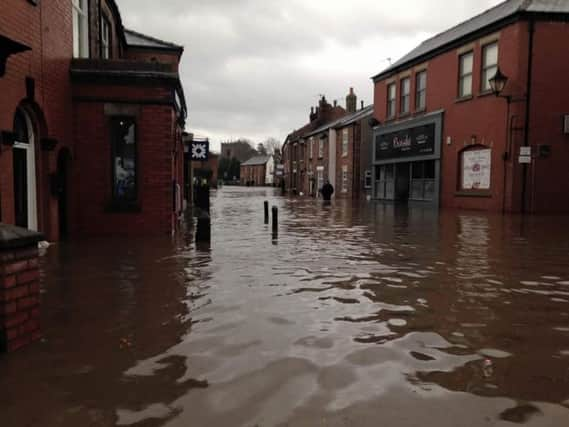When a record breaking storm hit town


On Thursday,August 10, 1893, a fierce thunderstorm hit Preston. In five minutes, about an inch and a quarter of rain fell – still a record for Britain.
Cellars were soon under water, while, we are told, ‘the premises of Messrs Wilding were flooded completely and men were engaged bare-legged in baling out the water.’
Advertisement
Hide AdAdvertisement
Hide AdIt must have been a bizarre sight when, in the midst of all this water, water everywhere, a wholesale grocer’s, in Church Street, was set on fire when it was struck by lightning.
The Lancashire Daily Post that day reported: “About four o’clock this afternoon a terrific thunderstorm, accompanied by vivid flashes of lightning, and torrents of rain mingled with hailstones of considerable size passed over Preston.
“The peals of thunder were unusually heavy for the district and so violent was the storm for the space of 20 minutes that all traffic in the streets was suspended.
“After a brief intermission the storm redoubled in violence, the rain being so heavy as to make it impossible to see across the main street.
Advertisement
Hide AdAdvertisement
Hide Ad“Some of the hailstones were as big as pigeon’s eggs, and they were mixed with irregular shaped pieces of ice.
“The streets in the low-lying portions of the town were flooded, in cases to a depth of two feet.
“Water poured into many of the cellars. It is stated a stable was flooded in Canal Street and a horse drowned.”
Lancashire also holds other British records for downpours. The most rain to fall in 15 minutes was 2.2 inches at Bolton Hall on July 18, 1964, while the record for 90 minutes goes to Dunsop Valley, with 4.6 inches on August 8, 1967.
Advertisement
Hide AdAdvertisement
Hide AdAll of these records were set during the summer, and another notable summer storm came on July 29, 1588.
This one did a fine job for England by destroying much of the Spanish Armada, but it also demolished the village of Singleton Thorpe, which stood off what is now Blackpool’s north shore, including its celebrated inn, the Penny O’Pint.
A number of villagers were drowned and the storm washed away so much of the coast that the settlement could not be rebuilt.
It was said that an ancient prophesy had foretold that the fate of Singleton Thorpe would be linked with the doom of a foreign power. A galleon from the Armada was beached by the storm near Rossall Grange.
Advertisement
Hide AdAdvertisement
Hide AdLocal men tried to board her, but were driven back by cannon and musket fire, and as the tide rose, the ship managed to escape.
Another storm in January 1839 brought a windfall for some Lancashire folk, when the Crusader bound to Bombay from Liverpool sank, shedding tempting silk and cotton goods along the Fylde coast, to which the inhabitants of Marton are said to have happily helped themselves.
The Crusader’s crew survived, but another vessel carrying tobacco was less fortunate, going down with all hands off Rossall, while 15 fishing boats were sunk at Lytham.
A reminder of how dangerous storms can be on land came early on the morning of February 27, 1903 when high winds blew over a mail train on the Leven viaduct, near Ulverston, after it had been brought to a standstill by fallen telegraph wires.
Advertisement
Hide AdAdvertisement
Hide AdNo one was killed, though more than 30 passengers were injured.
Nowadays we get warnings that the climate is getting more volatile, with the United Nations’ Intergovernmental Panel on Climate Change, which consults thousands of scientists all over the world, saying that storms will become fiercer and downpours heavier, and the past few years have certainly brought some particularly formidable ones.
The winter of 2013-4 saw some of the worst storms in living memory hit the Sefton coast with sand dunes suffering severe damage.
Then on December 5 last year, Storm Desmond brought havoc to the Lancaster area.
Advertisement
Hide AdAdvertisement
Hide AdAbout 61,000 homes lost their electricity when an electrical substation was flooded, along with the bus station and a supermarket, while Lancaster University and the Lancashire Campus of the University of Cumbria were forced to evacuate students.
And barely had Desmond subsided than along came Eva, which on Boxing Day brought the worst flooding ever recorded in West Lancashire, with nearly 300 properties inundated. Many people have still not been able to return.
Growing up in Manchester, one of my own most vivid weather memories was of the winter of 1962-63.
I played lacrosse at school, and our last pre-Christmas match in mid-December had to be cut short because of heavy rain.
Advertisement
Hide AdAdvertisement
Hide AdThen came the big freeze, and we did not play again until mid-March, when the melting snow and ice revealed unhealthy looking yellow grass instead of the usual lush green.
Some forecasters are saying we may get a taste of something similar this winter, but then, as the film producer Sam Goldwyn warned, you need to beware of making predictions, especially about the future.
l Storm: Nature and Culture by John Withington is published by Reaktion Books. Price £14.95. ISBN 9781780236612.